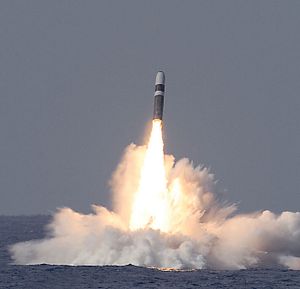The United States has started production of a new low-yield nuclear warhead for its Trident D5 submarine-launched ballistic missiles. The new warhead was identified by the Trump administration as a key new nuclear capability in its 2018 Nuclear Posture Review (NPR).
Assembly of the new warhead, which is based on the existing W76 warhead, has started at the Pantex Plant in Tennessee, according to reports citing a U.S. National Nuclear Security Administration (NNSA) statement. NNSA, under the U.S. Department of Energy, is charged with the manufacture and maintenance of U.S. nuclear weapons.
The new weapon is known as the second modification of the W76, or the W76-2. Though NNSA has not specified the changes that have been made from the initial thermonuclear version of the warhead, which has a yield of around 100 kilotons of TNT equivalent explosive power, the W76-2 is thought to be a primary-only version of the original W76, reducing its yield to the single-digit kiloton range.
The NNSA’s Stockpile Stewardship and Management Plan for the 2019 fiscal year noted that work on the new warhead would begin this year and run through the 2024 fiscal year.
The strategic need for the weapon was outlined by the Trump administration in the 2018 NPR, but several arms control advocates and experts have underlined the likelihood of the new weapon increasing ambiguity and reducing the nuclear-use threshold for the United States.
“Expanding flexible U.S. nuclear options now, to include low-yield options, is important for the preservation of credible deterrence against regional aggression,” the 2018 document noted. The justification for the low-yield D5 in the NPR is specifically to “ensure a prompt response option that is able to penetrate adversary defenses.”
Low-yield warheads will “help ensure that potential adversaries perceive no possible advantage in limited nuclear escalation, making nuclear employment less likely” the NPR notes.
The measure is described as a “low-cost and near term modification.” The production of the first W76-2 warheads in 2019 comes just under one year after the release of the NPR.
While the Trump administration has argued that this new warhead will lessen the likelihood of nuclear war by giving the United States a less escalatory weapon to deter regional aggression by Russia, opponents of the low-yield weapon argue otherwise.
Specifically, one of the main concerns among critics is that the new warhead will be impossible for adversaries to discriminate once launched, leading them to conclude that a regular D5 SLBM carrying multiple full-yield W76 warheads may have been launched.
The new warhead will deploy on some Trident D5 SLBMs on board existing U.S. Ohio-class ballistic missile submarines, alongside the high-yield W76-1 and W88 thermonuclear warheads.

































